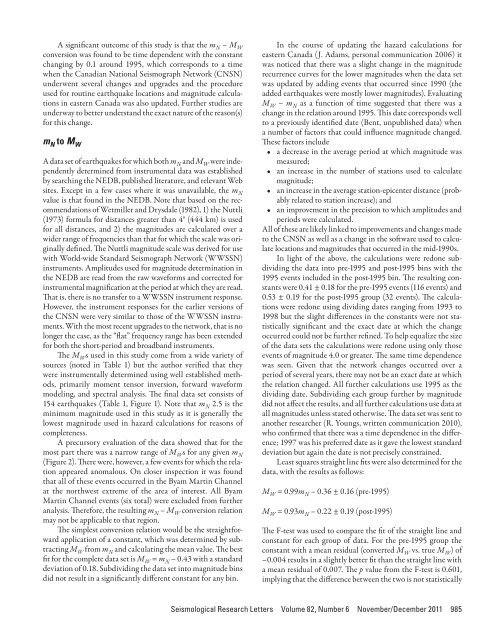Here - Stuff
Here - Stuff
Here - Stuff
You also want an ePaper? Increase the reach of your titles
YUMPU automatically turns print PDFs into web optimized ePapers that Google loves.
A significant outcome of this study is that the m N – M Wconversion was found to be time dependent with the constantchanging by 0.1 around 1995, which corresponds to a timewhen the Canadian National Seismograph Network (CNSN)underwent several changes and upgrades and the procedureused for routine earthquake locations and magnitude calculationsin eastern Canada was also updated. Further studies areunderway to better understand the exact nature of the reason(s)for this change.m N to M WA data set of earthquakes for which both m N and M W were independentlydetermined from instrumental data was establishedby searching the NEDB, published literature, and relevant Websites. Except in a few cases where it was unavailable, the m Nvalue is that found in the NEDB. Note that based on the recommendationsof Wetmiller and Drysdale (1982), 1) the Nuttli(1973) formula for distances greater than 4° (444 km) is usedfor all distances, and 2) the magnitudes are calculated over awider range of frequencies than that for which the scale was originallydefined. The Nuttli magnitude scale was derived for usewith World-wide Standard Seismograph Network (WWSSN)instruments. Amplitudes used for magnitude determination inthe NEDB are read from the raw waveforms and corrected forinstrumental magnification at the period at which they are read.That is, there is no transfer to a WWSSN instrument response.However, the instrument responses for the earlier versions ofthe CNSN were very similar to those of the WWSSN instruments.With the most recent upgrades to the network, that is nolonger the case, as the “flat” frequency range has been extendedfor both the short-period and broadband instruments.The M W s used in this study come from a wide variety ofsources (noted in Table 1) but the author verified that theywere instrumentally determined using well established methods,primarily moment tensor inversion, forward waveformmodeling, and spectral analysis. The final data set consists of154 earthquakes (Table 1, Figure 1). Note that m N 2.5 is theminimum magnitude used in this study as it is generally thelowest magnitude used in hazard calculations for reasons ofcompleteness.A precursory evaluation of the data showed that for themost part there was a narrow range of M W s for any given m N(Figure 2). There were, however, a few events for which the relationappeared anomalous. On closer inspection it was foundthat all of these events occurred in the Byam Martin Channelat the northwest extreme of the area of interest. All ByamMartin Channel events (six total) were excluded from furtheranalysis. Therefore, the resulting m N – M W conversion relationmay not be applicable to that region.The simplest conversion relation would be the straightforwardapplication of a constant, which was determined by subtractingM W from m N and calculating the mean value. The bestfit for the complete data set is M W = m N – 0.43 with a standarddeviation of 0.18. Subdividing the data set into magnitude binsdid not result in a significantly different constant for any bin.In the course of updating the hazard calculations foreastern Canada (J. Adams, personal communication 2006) itwas noticed that there was a slight change in the magnituderecurrence curves for the lower magnitudes when the data setwas updated by adding events that occurred since 1990 (theadded earthquakes were mostly lower magnitudes). EvaluatingM W – m N as a function of time suggested that there was achange in the relation around 1995. This date corresponds wellto a previously identified date (Bent, unpublished data) whena number of factors that could influence magnitude changed.These factors include• a decrease in the average period at which magnitude wasmeasured;• an increase in the number of stations used to calculatemagnitude;• an increase in the average station-epicenter distance (probablyrelated to station increase); and• an improvement in the precision to which amplitudes andperiods were calculated.All of these are likely linked to improvements and changes madeto the CNSN as well as a change in the software used to calculatelocations and magnitudes that occurred in the mid-1990s.In light of the above, the calculations were redone subdividingthe data into pre-1995 and post-1995 bins with the1995 events included in the post-1995 bin. The resulting constantswere 0.41 ± 0.18 for the pre-1995 events (116 events) and0.53 ± 0.19 for the post-1995 group (32 events). The calculationswere redone using dividing dates ranging from 1993 to1998 but the slight differences in the constants were not statisticallysignificant and the exact date at which the changeoccurred could not be further refined. To help equalize the sizeof the data sets the calculations were redone using only thoseevents of magnitude 4.0 or greater. The same time dependencewas seen. Given that the network changes occurred over aperiod of several years, there may not be an exact date at whichthe relation changed. All further calculations use 1995 as thedividing date. Subdividing each group further by magnitudedid not affect the results, and all further calculations use data atall magnitudes unless stated otherwise. The data set was sent toanother researcher (R. Youngs, written communication 2010),who confirmed that there was a time dependence in the difference;1997 was his preferred date as it gave the lowest standarddeviation but again the date is not precisely constrained.Least squares straight line fits were also determined for thedata, with the results as follows:M W = 0.99m N – 0.36 ± 0.16 (pre-1995)M W = 0.93m N – 0.22 ± 0.19 (post-1995)The F-test was used to compare the fit of the straight line andconstant for each group of data. For the pre-1995 group theconstant with a mean residual (converted M W vs. true M W ) of–0.004 results in a slightly better fit than the straight line witha mean residual of 0.007. The p value from the F-test is 0.601,implying that the difference between the two is not statisticallySeismological Research Letters Volume 82, Number 6 November/December 2011 985
















